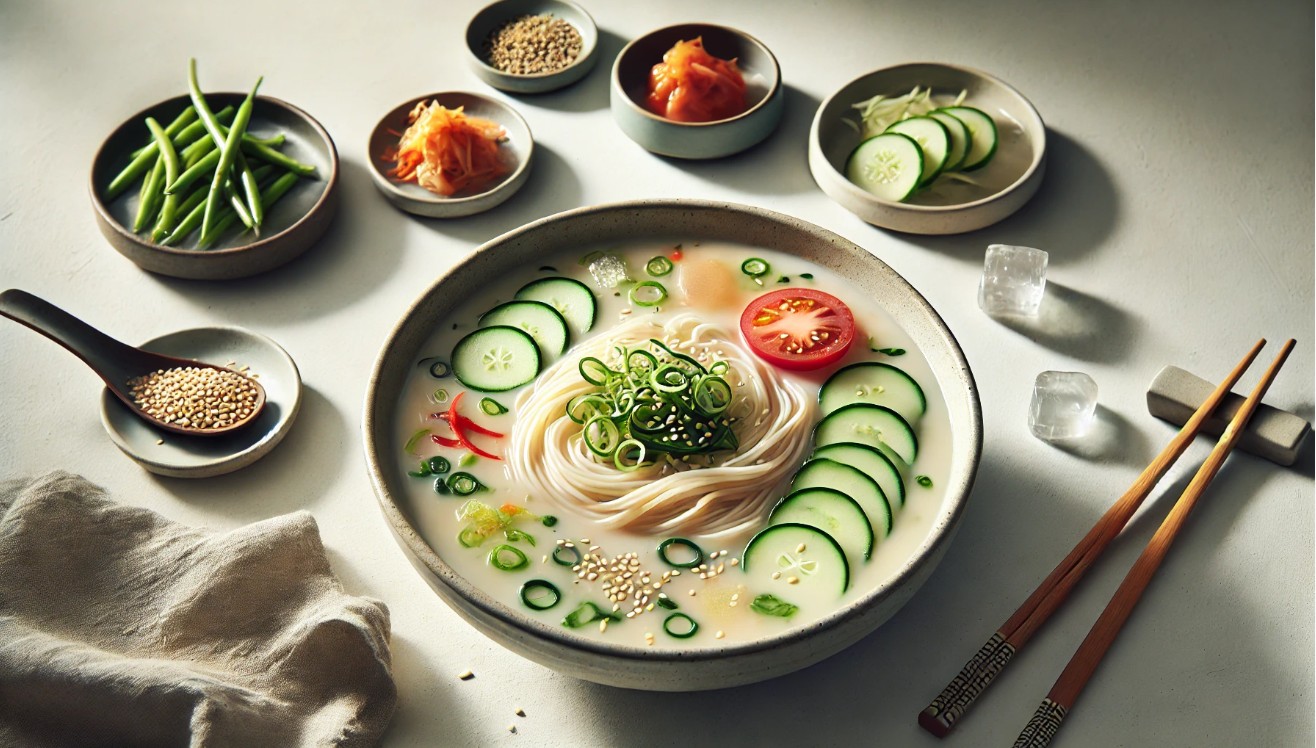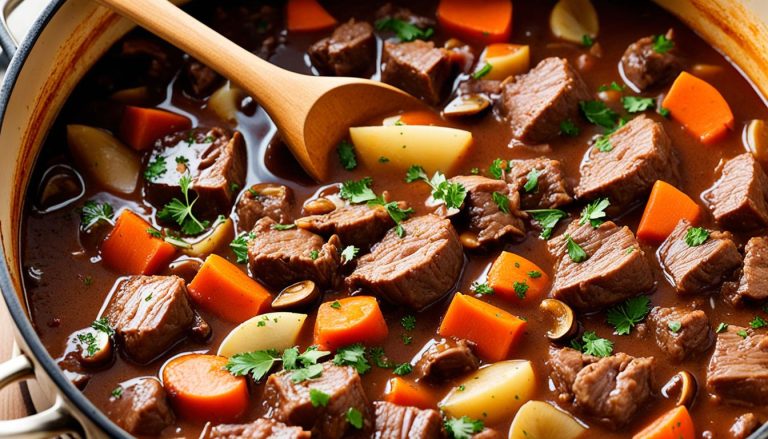Kongguksu is a traditional Korean cold noodle dish known for its smooth, creamy soybean broth and soft wheat noodles.
This cooling summer meal offers a light, nutty flavour and a silky, velvety texture. Served with fresh toppings like cucumber, tomatoes, and sesame seeds, kongguksu is the perfect way to beat the heat.
The dish is deeply rooted in Korean culinary tradition, highlighting the simplicity of wholesome, plant-based ingredients. Its naturally vegan profile makes it a popular choice for vegetarians and health-conscious foodies.
As one of Korea’s most iconic summer dishes, the kongguksu recipe is beloved for its refreshing qualities, providing nourishment and relief during the hottest months of the year.
What is Kongguksu?
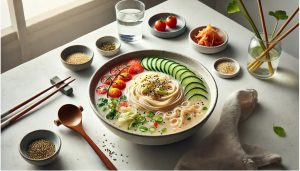
Kongguksu (콩赭수) is a cold noodle dish from Korea that consists of soft wheat noodles in a cool, creamy soybean broth.
The name “kong” (콩) means “soybean,” while “guksu” (국수) refers to “noodles,” perfectly describing its two main components. The broth is made by blending soaked and cooked soybeans with water, creating a rich, nutty, and smooth soup base.
Unlike other cold noodle dishes, kongguksu is mild and creamy rather than tangy or spicy. Often served with ice cubes to keep it extra cold, it embodies the perfect summer comfort food.
The mild flavors are complemented by fresh garnishes, and the silky soybean broth offers a satisfying balance of taste, texture, and nourishment.
Kongguksu has been a staple summer dish in Korea for centuries. Its light, refreshing taste makes it a favorite during the hot, humid months. Unlike hot soups that provide warmth in winter, kongguksu provides cooling relief, offering hydration and nutrition in one bowl.
The dish reflects the essence of Korean temple cuisine, known for its use of simple, natural ingredients. With soybeans as the central component, kongguksu showcases how Korean cuisine makes use of nutrient-dense, plant-based ingredients.
The creamy broth has a subtle richness that feels indulgent but remains healthy, appealing to vegans, vegetarians, and anyone looking for a refreshing summer meal.
Kongguksu Recipe Ingredients
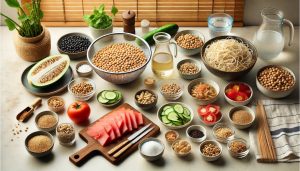
To make an authentic bowl of kongguksu, you’ll need only a few key ingredients. The star of the dish is the soybean, but the toppings and garnishes add depth and freshness.
- Soybeans: The Star Ingredient: The heart of kongguksu is its soybean broth. Dried soybeans are soaked, boiled, and blended with cold water to create a smooth, nutty, and creamy soup base. This rich, velvety texture is what makes kongguksu so unique.
- Noodles: The Base of the Dish: Thin wheat-based somyeon (소면) noodles are traditionally used in kongguksu. These noodles are soft, chewy, and absorb the creamy soybean broth beautifully. They are boiled, rinsed in cold water, and served cold in the soybean broth.
Toppings: Freshness and Flavor
- Cucumber: Thinly sliced cucumber adds a fresh, crunchy texture to the dish.
- Tomato: Some variations include fresh tomato slices to add sweetness and acidity.
- Watermelon (optional): In some modern takes on kongguksu, slices of watermelon add sweetness and freshness.
- Sesame Seeds: Toasted sesame seeds add a nutty aroma and flavor.
- Ice Cubes: Some people add ice cubes to the broth to keep it extra cold.
Seasonings
- Salt: Salt is used to season the soybean broth to taste.
- Sugar (optional): Some people like to add a pinch of sugar for a subtle sweetness.
Ingredients
Here’s the table with the updated content without the notes:
| Ingredient | Amount |
| Dried Soybeans | ½ cup |
| Cold Water | 3-4 cups |
| Somyeon (Thin Wheat Noodles) | 200g |
| Toasted Sesame Seeds | 2 tablespoons |
| Pine Nuts | 2 tablespoons (optional) |
| Cucumber | ½, thinly sliced into matchsticks |
| Tomato | 1 small, sliced |
| Salt | To taste |
| Ice Cubes | As needed (optional) |
This table neatly organizes the ingredients and their respective amounts.
Kongguksu Recipe Step-by-Step Instructions
Follow these simple steps to create an authentic, delicious bowl of kongguksu at home.
Prepare the Soybeans

- Soak ½ cup of dried soybeans in water overnight (6-8 hours).
- Drain and rinse the soybeans.
- Cook the soybeans in boiling water for 20-30 minutes or until tender.
- Cool the cooked soybeans for 10-15 minutes.
Make the Soybean Broth

- Add the cooked soybeans, 3-4 cups of cold water, 2 tablespoons of toasted sesame seeds, and 2 tablespoons of pine nuts to a blender.
- Blend on high speed until the mixture becomes smooth and creamy.
- For an extremely smooth texture, strain the mixture through a fine screen to get rid of any solids.
- Chill the soybean broth in the refrigerator for at least 1 hour.
Cook the Noodles

- Boil 200g of somyeon noodles according to the package instructions.
- Once cooked, rinse the noodles under cold running water to stop the cooking process and remove excess starch.
- After draining, portion the noodles onto serving dishes.
Assemble the Kongguksu

- Pour the chilled soybean broth over the noodles, ensuring they are fully submerged.
- Add toppings such as cucumber, tomato, and sesame seeds.
- Optionally, add ice cubes to keep the soup extra cold.
- Serve immediately and enjoy.
Kongguksu Recipe Nutrition Facts
| Nutrient | Amount per Serving |
| Calories | 350kcal |
| Protein | 15g |
| Carbohydrates | 45g |
| Fats | 5g |
| Vitamins | Rich in B vitamins, vitamin C, K |
| Minerals | Contains iron, calcium, magnesium, potassium |
This balanced nutritional profile makes Kongguksu a wholesome and refreshing choice for a meal.
Kongguksu Recipe Variations and Adaptations
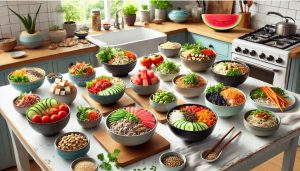
One of the great things about kongguksu is its adaptability. From plant-based enhancements to texture variations, there are several ways to customize this classic dish to suit dietary preferences or culinary creativity.
Below are some of the most popular and creative adaptations of kongguksu:
1. Vegan and Vegetarian-Friendly Versions
Kongguksu is inherently vegan, made from a simple blend of soybeans, water, and wheat noodles, but it can be enhanced with protein-rich additions. Incorporating fried tofu, tempeh, sautéed mushrooms, or boiled edamame not only boosts the dish’s nutritional value but also adds exciting textures and flavors.
2. Alternative Broth Flavors
Although traditional kongguksu primarily relies on soybeans for its broth, inventive cooks can create creamy alternatives using other ingredients.
Options include blending soaked cashews or almonds for a nuttier flavor, incorporating peanuts for added sweetness, or opting for store-bought unsweetened soy milk as a convenient shortcut, albeit with a milder taste.
3. Noodle Alternatives
If somyeon noodles are unavailable, you can easily substitute them with various alternatives to suit your dietary needs.
Options include gluten-free rice or shirataki noodles for a lighter option, spiralized zucchini or cucumber noodles for a low-carb twist, and thicker udon or nutty soba noodles that provide a richer texture and improve the dish as a whole.
4. Unique Toppings and Additions
Adding toppings to kongguksu allows for a creative and personalized touch, transforming this classic dish into something uniquely yours.
While traditional toppings like cucumber and tomato are common, you can enhance the flavor profile by experimenting with fresh fruits like watermelon or peaches for sweetness, hard-boiled eggs for additional protein, vibrant herbs for freshness, and crunchy crushed nuts or seeds for added texture and depth.
5. Spicy Versions
To give kongguksu an extra kick, you can sprinkle Korean gochugaru for a mild heat, drizzle chili oil to enhance the broth’s nutty flavor, or use chili crisp as a crunchy topping that adds both spice and texture. These additions allow you to tailor the dish to your preferred spice level while elevating its overall flavor profile.
Kongguksu Recipe Serving and Pairing Suggestions

- Kimchi: The spicy, tangy flavors of kimchi perfectly balance the mild, nutty taste of kongguksu. The acidity and heat from kimchi complement the creamy soup, making for a dynamic contrast.
- Pickled Radish: The crunchy, tart pickled radish adds a fresh and slightly sour element, enhancing the overall flavor experience and providing a crisp texture to offset the softness of the noodles.
- Fresh Summer Fruits: Sweet, refreshing fruits like watermelon, grapes, or sliced peaches provide a cooling contrast to the richness of the kongguksu broth, making the meal feel lighter and more balanced, especially on hot days.
- Kimbap (Rice Rolls): For a heartier meal, serve kongguksu alongside kimbap, a Korean rice roll filled with vegetables, egg, and sometimes meat. The variety of textures and flavors in the kimbap pairs wonderfully with the simplicity of kongguksu.
- Crispy Tofu Bites: Add some crispy tofu for a protein-packed side that offers a satisfying crunch, balancing the creamy soup with a savory, crispy texture.
- Extra Toppings: Enhance the dish with additional toppings such as hard-boiled eggs, shredded lettuce, or shredded carrots. These additions not only provide extra freshness and color but also introduce more layers of flavor and texture to the meal.
Tips for Perfect Kongguksu Every Time
To achieve restaurant-quality kongguksu at home, follow these essential tips:
- Use High-Quality Soybeans: Fresh, high-quality soybeans result in a richer, creamier broth. Organic, non-GMO soybeans are best for flavor and texture.
- Blend the Broth Thoroughly: Use a high-speed blender to create a smooth, creamy broth. Strain the liquid through a sieve to remove any remaining pulp for a velvety texture.
- Serve it Ice-Cold: For an authentic experience, ensure the soybean broth is thoroughly chilled before serving. Add ice cubes to the bowl to keep it extra cold.
- Avoid Overcooking the Noodles: Cook the noodles just until al dente and rinse them under cold water to stop the cooking process. This keeps them firm and chewy.
- Adjust Seasoning Last: Salt should be added right before serving. Adjust the salt to taste, but be careful not to over-salt.
Conclusion
Kongguksu is a light, refreshing summer dish that captures the essence of Korean cuisine. The creamy soybean broth, soft noodles, and fresh toppings make it a healthy, nutritious option for vegetarians, vegans, and anyone looking for a wholesome summer meal.
Its simplicity, elegance, and health benefits have made it a beloved staple in Korean homes. Experience the joy of kongguksu on a hot summer day and savor the creamy, nutty broth with every bite. Its timeless appeal as a cooling comfort food has kept it a treasured part of Korean culinary heritage.
FAQS
Is kongguksu suitable for vegan diets?
Yes, kongguksu is inherently vegan, as it is made from soybeans, water, and wheat noodles. It can be further enhanced with protein-rich toppings like tofu or tempeh to cater to plant-based diets.
How do I prepare the soybean broth for kongguksu?
To make the soybean broth, soak dried soybeans overnight, then cook them until tender. Blend the cooked soybeans with cold water and strain the mixture for a smooth, creamy texture before chilling it in the refrigerator.
Can I substitute somyeon noodles in kongguksu?
Absolutely! If somyeon noodles are unavailable, you can use gluten-free noodles, spiralized zucchini, or thicker udon and soba noodles as substitutes to suit your dietary preferences.
What are some common toppings for kongguksu?
Common toppings include sliced cucumbers, tomatoes, sesame seeds, and optional additions like hard-boiled eggs, fresh herbs, and even fruits such as watermelon for added sweetness and variety.
How can I add spice to my kongguksu?
To spice up your kongguksu, sprinkle Korean gochugaru (red chili flakes), drizzle chili oil, or add chili crisp as a crunchy topping to introduce heat and enhance the dish’s nutty flavor.
What are some serving suggestions for kongguksu?
Kongguksu pairs well with kimchi, pickled radish, fresh summer fruits, kimbap, and crispy tofu bites, providing a balance of flavors and textures to complement the dish.
What tips can help me achieve the best kongguksu?
Use high-quality soybeans, blend the broth thoroughly for creaminess, serve the dish ice-cold, avoid overcooking the noodles, and adjust salt seasoning right before serving to ensure optimal flavor and texture.

Kongguksu Recipe
Ingredients
- ½ cup Dried Soybeans
- 3-4 cups Cold Water
- 200 g Somyeon Thin Wheat Noodles
- 2 tablespoons Toasted Sesame Seeds
- 2 tablespoons Pine Nuts optional
- ½ Cucumber thinly sliced into matchsticks
- 1 small Tomato sliced
- To taste Salt
- As needed Ice Cubes optional
Instructions
- Soak ½ cup of dried soybeans in water overnight (6-8 hours).
- Drain and rinse the soybeans.
- Cook the soybeans in boiling water for 20-30 minutes or until tender.
- Cool the cooked soybeans for 10-15 minutes.
- Add the cooked soybeans, 3-4 cups of cold water, 2 tablespoons of toasted sesame seeds, and 2 tablespoons of pine nuts to a blender.
- Blend on high speed until the mixture becomes smooth and creamy.
- For an extremely smooth texture, strain the mixture through a fine screen to get rid of any solids.
- Chill the soybean broth in the refrigerator for at least 1 hour.
- Boil 200g of somyeon noodles according to the package instructions.
- Once cooked, rinse the noodles under cold running water to stop the cooking process and remove excess starch.
- After draining, portion the noodles onto serving dishes.
- Pour the chilled soybean broth over the noodles, ensuring they are fully submerged.
- Add toppings such as cucumber, tomato, and sesame seeds.
- Optionally, add ice cubes to keep the soup extra cold.
- Serve immediately and enjoy.


